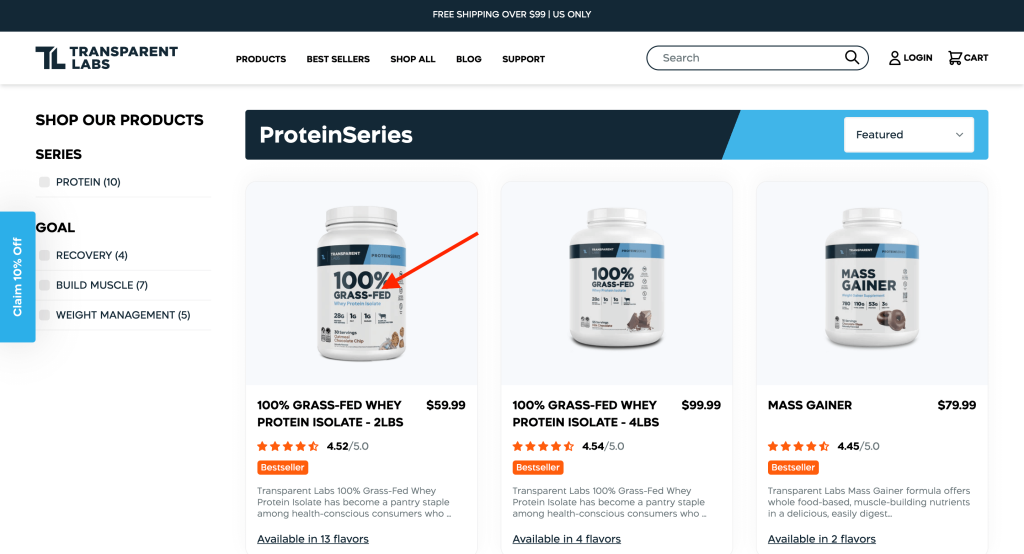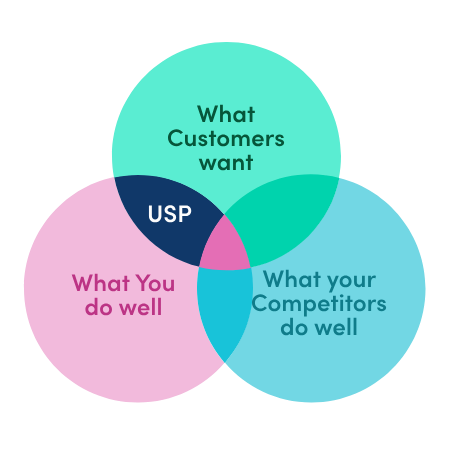David Brier, a writer and business coach, has called branding ” the art of differentiation.”
In other words, what makes your company unique? In a crowded market, unique selling propositions are often the winning factor between brands that succeed and brands that fail.
What is a Unique Selling Proposition?
Simply put, USPs are what make one company different from the next.
There are thousands of companies that sell shoes. How many of those companies donate a pair to a person in need after every purchase?
That distinction belongs to Toms Shoes. For someone who wants to do a little good with their shopping, it may be enough of a distinguishing factor to earn Toms a sale.
Or maybe you are into fitness but you worry about the artificial additives in protein powders. Transparent Labs builds its brand around natural ingredients and honest labeling. Its USP is built into its name.

USPs can be anything.
How the brand approaches customer experience, its pricing strategy, or its worldview. The key is to understand what your demographic wants and develop a unique way to give it to them.
It’s an important thing to get right. USPs keep customers engaged.
To some people, they matter more than the item’s selling price. In this article, we take a look at six unique selling point example companies that you should know about.
Example 1 – Zappos: “Powered by Service”
Tony Hsieh, Zappos CEO, has never been in the pizza business.
Yet, after arriving back at his hotel late at night with a group of hungry clients, he knew just how to satisfy their cravings. Call Zappos.
It was 2 AM when Hsieh’s client called the Zappos customer service line.
His request—a pizza—was taken seriously.
The fashion brand customer service representative found multiple parlors open near the hotel and even placed the order for them.
Zappos is famous for this.
Sending flowers to a customer after learning her mother had recently passed away. A CX call that went on for a record-breaking ten hours.
These stories, of course, are outliers. However, they reflect the brand’s true commitment to excellence in customer service.
No, Zappos isn’t the only company in the world selling UGG boots. But what other brand can compete with its commitment to WOW-level service?
E-commerce stores selling clothes are a dime a dozen. Zappos’s “Powered by service,” business model allows it to stand out in a crowded marketplace. What other company regularly goes viral for how it handles customer service calls?
Example 2 – M&Ms: Chocolate that Melts in Your Mouth, Not Your Hand

In the first act of Tommy Boy, Chris Farley’s character is picked up by Richard, a man played by David Spade. Farley immediately spills an entire bag of M&Ms into a dashboard vent.
Richard says, “Oh, that’s good. Melted chocolate right inside the dash. That improves the resale value.”
Farley says, “I think you’ll be okay here, they have a thin candy shell. ‘Surprised you didn’t know that.”
It’s easy to take M&Ms for granted at this stage in the game. Candyshelled chocolates have been so deeply a part of the confectionery cannon for decades now.
However, when they first hit the scene in 1941, they solved a real concern for candy lovers worldwide: How do I enjoy my treat on the go without becoming a sticky mess?
Answer?
That thin candy shell Tommy Boy references to such amusing effect. Common though they may now seem, M&Ms are a legitimately unique product that offers a simple solution to an existing problem.
Takes notes: This is the recipe for any great USP.
Example 3 – Dollar Shave Club: ” Great A Shave for a Few Bucks a Month”
“A great shave for a few bucks a month.” Or, more recently, “Shave time. Shave money.”
Their selling proposition is simple but enticing.
Spend less money on a product you need. They didn’t invent this business model.
It’s effectively the same concept that applies to any subscription business.
Pay a nominal fee. Enjoy more convenient access to a product you need anyway. Dollar Shave Club didn’t invent a better razor. They instead developed a business model that reflects the pain points people experience around shaving.
Razors need to be replaced constantly.
It’s inconvenient.
It’s a little pricey. Dollar Shave Club’s USP addresses both concerns with one simple solution.
Example 4 – Patagonia: “We’re in Business to Save Our Home Planet”
“We’re in business to save our home planet.” That’s a strong statement. In less than ten words, Patagonia manages to elevate its brand beyond the confines of standard terms.
Where M&M is focused on making a more convenient candy, Patagonia has set its sights higher. They sell outdoor gear.
Their customers have a built-in appreciation for nature. By committing to high-quality recycled materials, and other sustainable production and delivery methods, Patagonia does more than sell hiking equipment. They give customers the chance to contribute to the greater good.
The result? A passionate, loyal customer base who comes for the products and stays for the overall brand experience.
Example 5 – Domino’s Pizza: “You Got 30 Minutes”
Domino’s 30-minute guarantee is now viewed as a failure.
Yet, when it first debuted, it made the pizza franchise stand out in a crowded marketplace. At the time, Domino’s could not compete with existing franchises, only on the grounds of quality.
They needed an added element of convenience to set them apart. Pizza at your door in thirty minutes or less.
Domino’s built its entire business model around this promise. They employed more drivers than cooks.
Used boxes that folded faster than any other on the market. They also put enormous pressure on their staff to live up to the promise.
Infamously, in 1985, a teenage driver pulled out of the Domino’s parking lot with less than ten minutes to get his pizza out to the customer. He immediately T-boned an oncoming car, causing injuries to the couple inside.
The story goes that the store manager reached into the crashed driver’s car and retrieved the pizza, handing it off to another driver with this encouragement: “There’s still time.”
True or false?
At this point, it doesn’t matter. The story reflects the element of pressure that made, and then nearly broke, an international brand.
The issue came to a head in 1993 when a woman successfully sued Domino’s after being injured by one of their drivers. At this point, reckless driving became as synonymous with the brand as fast deliveries.
Ultimately, Domino’s delivery policy is hard to view explicitly as a failure. It was implemented to organically grow the brand. Focus less on marketing and more on growing an enthusiastic roster of customers.
For decades, this plan worked. And as the so-called “Pizza Wars” of the 80s unfolded, thirty-minute deliveries served as a distinct advantage. A person might prefer Pizza Hut’s taste, but not necessarily enough to wait an hour to get it.
So, what is the takeaway? Domino’s did a lot of things right. Their USP was:
- Simple.
- Enticing.
- Unique.
These are key ingredients to a great USP.
The ultimate problem was sustainability. The brand risked a lot making a promise that couldn’t always be easily upheld.
Example 6 – The Honest Company: “Safe, Effective Products You Can Trust”
Like Patagonia, the Honest Company taps into something visceral. Personal values. The customer’s belief in something bigger than commerce. Health. Safety. Sustainability.
The Jessica Alba-owned company makes eco-friendly household products geared towards families. It offers sustainably sourced diapers, safe lotions, shampoos, and baby wipes.
Why does this business model work?
It taps into several concerns common to the new parent.
Babies are incredibly vulnerable. Worried parents have a justifiable concern over products that rely on dangerous chemicals.
Environmentally aware parents also know that babies create an enormous amount of waste.
How many diapers does one baby go through in a day? The person responsible for changing them may estimate the number falls somewhere in the hundreds. In actuality, it’s about six.
Still, that’s more than 2000 diapers a year—an incredible amount of landfill accumulation brought on by someone so new and so small.
The Honest Company provides a clear solution to these issues. Sustainably sourced products that parents can feel good about giving to their children.
No, they aren’t reinventing baby care. Perhaps, however, they are doing as Emerson once recommended. The philosopher wrote, “Build a better mouse trap, and the world will beat a path to your door.”
This simple phrase says a lot about developing a USP: Find a familiar concept and improve it. The Honest Brand has done this with great success.
Their products cost more money than competing options.
However, parents who buy Honest brand products do not just purchase a box of diapers.
They are buying into a worldview. They are taking care of the planet and making a safer choice for their child.
How can you put a price on that? Well, the Honest Company has managed to do exactly that. It’s working out quite well for them. The company is currently valued at more than a billion dollars.
Developing a Unique Selling Proposition
The brands included in our list today accomplished several key things :
- Innovation: Think M&M’s. Familiar product repackaged conveniently.
- Quality of service: Zappos and Domino’s. Both developed customer experience strategies that are quite literally newsworthy. Zappos has managed to provide sustainable customer service policies that continue to be the gold standard. Domino’s didn’t. Still, they did something right. We are talking about them, aren’t we?
- Representation: The Honest Company. Patagonia. Companies that understand their demographic and create a unique selling point that transcends the typical confines of commerce.
People buy products from these brands because it makes them feel like they are part of something bigger. Because these brands and their products complement their worldview.
Keep in mind that your unique selling proposition does not need to be groundbreaking. Consider the Dollar Shave Club.
They leverage a simple idea. Easy, affordable access to razors.
Yet they have tapped into something fundamental. Good selling propositions reflect a keen understanding of your customers’ needs and wants.
They help you connect with your audience and develop a healthy roster of loyal customers.
Figure out how to give it to them in a way that no one else is doing and you’ll have a winning concept. Don’t know where to start?
Take a look at what your competitors are doing. What twist on the existing marketplace can you offer?
That may be your USP.
Granted, having a USP is not enough.
You also need to be able to communicate it. Feature your USP in your marketing. Use tools like email automation software to get the message across easily.
Also, leverage QR code generators, SEO platforms, and even AI to reach your audience effectively.
Develop an easy-to-navigate, mobile-friendly website.
Good ideas are awesome, but they only get you so far. If an amazing USP launches on the internet and no one is around to hear it, it does not make a sound.
Final Thoughts on Unique Selling Propositions
Without a unique selling proposition, you don’t have a brand. Why should a customer choose you instead of someone else? That’s the question.
Your unique selling proposition is the answer.
By its nature, every USP will be different.
Whether you appeal to your customers’ values or their desire for comfort and convenience unique selling proposition should directly address a problem.
Keep in mind that your USP doesn’t have to be so over the top that it warrants inclusion in articles like this one. For example, the Patel Firm sets itself apart from other Texas Law firms by offering riskless, no-fee consultations.
A simple but highly appealing promise anyone in need of a lawyer will want to keep in mind.
Sometimes, that’s all it takes. Build a better mousetrap. The world may just beat a path to your door.
Guest Author: Freya Laskowski
Freya Laskowski is the founder and CEO of SERPManiac, an agency focused on helping brands scale their organic growth with content marketing and SEO services.
She is a quoted contributor in online publications like Business Insider, Fox Business, Yahoo Finance, and the Huffington Post. She also owns CollectingCents– a personal finance blog that she grew from the ground up.













